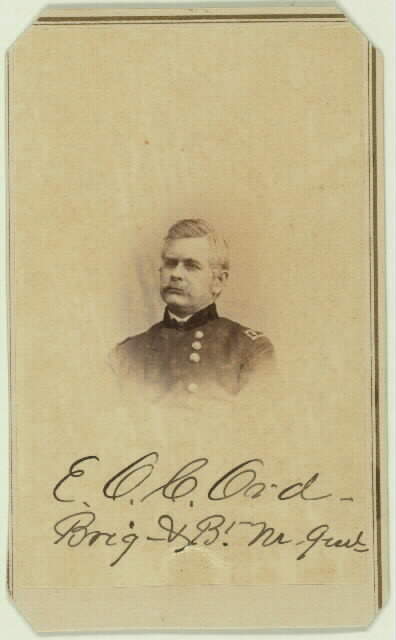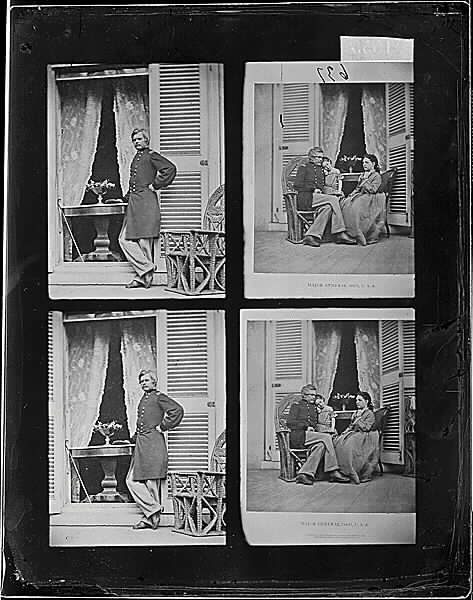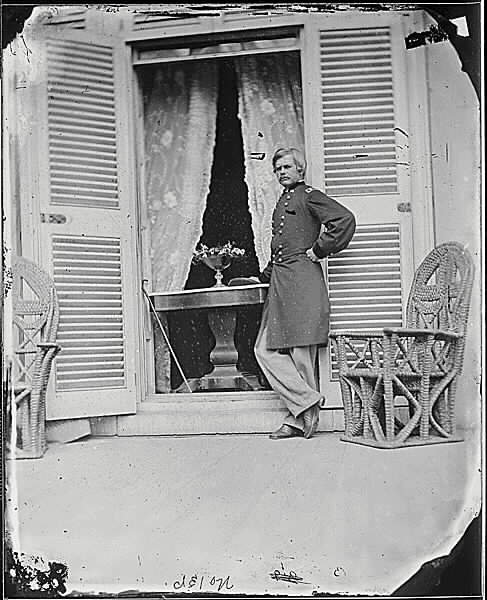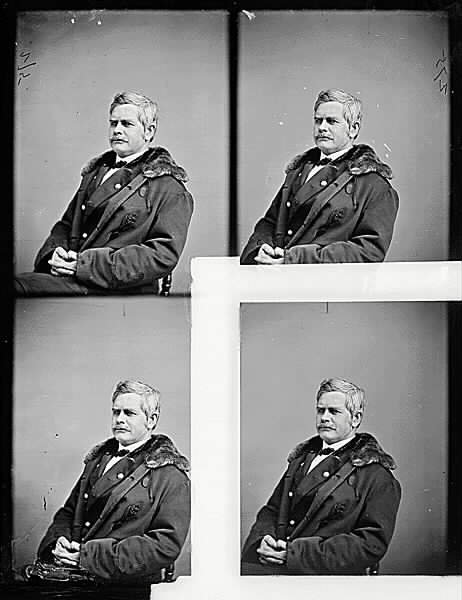Born in Cumberland, Maryland, on October 18, 1818, but when he was one year old, his family moved to Washington, D.C., where he received his early education. His father, James Ord, was thought to be a natural son of George IV of England by his morganatic marriage to Mrs. Fitzerbert. This is a family tradition which was verified years ago by a great-great-nephew of E.O.C. Ord Preston of La Jolla, California.
At the age of 16 he received appointment to West Point, graduating in 1839. His field service was principally against the troublesome Florida Seminole Indians. During the Civil War he served in the Western Frontier and was an extremely capable field commander. He was severely wounded in 1862 and did not return to duty until 1863.
Later, he had commands in Louisiana and in the Shenandoah Valley and was assigned to VIII Corps in operations before Richmond, Virginia. During s successful attack on Fort Harrison in September 1864 he was again seriously wounded and did not resume command until January 1865, when he took command of the Army of the James and the Department of North Carolina. After the war, he commanded various military departments, was made a Brigadier General in the Regular Army as of July 26, 1866.
He retired as a Major General in 1881.
While on a ship from New York to Cuba he was stricken with yellow fever and he died in Havana on July 22, 1883. He is buried in Section 2 of Arlington National Cemetery among many of his family members.
0RD Edward 0tho Cresap, soldier, born in Cumberland, Maryland, 18 October, 1818; died in Havana, Cuba, 22 July, 1883.
He showed in his boyhood great mathematical ability, which attracted attention and gained for him an appointment to the United States Military Academy, where he was graduated in 1839.
On his graduation he was assigned to the 3d artillery, and served in the Florida war against the Seminole Indians in 1839-’42, winning his promotion as 1st lieutenant in 1841. He was one of two lieutenants that were selected by Colonel William S. Harney to assist in attacking the Indians in the Everglades. During the four following years he served on garrison duty on the eastern seaboard, in 1847, with his classmate, Lieutenant Henry W. Halleck, and Lieutenant William T. Sherman, he was sent to California by way of Cape Horn, and by his individual efforts did much toward preserving law and order in Monterey during the latter part of the Mexican war.
In 1850 he returned to the east and was made captain, but after two years’ service in Fort Independence, Massachusetts, he went back to California and was engaged on coast survey duty until 1855. He then took part in Indian warfare, again participating in the campaigns against the Rogue river Indians in Oregon in 1856 and in that against the Spokane Indians in Washington territory in 1858.
He was stationed at the Presidio in San Francisco at the beginning of the Civil War, but in September, 1861, was made Brigadier General of volunteers and given a command in the Army of the Potomac. In November he was promoted Major and assigned the 3d brigade of Pennsylvania reserves. His first engagement was at Dranesville, where he defeated the Confederates after a sharp contest of several hours. Following the defeats of Bull Run and Bali’s Bluff, this victory did much toward raising the spirits of the soldiers. General John F. Reynolds said at the time : “I knew if there was a fight to be seared up, Ord would find it.”
Later he was sent down the valley of Virginia with General Franz Sigel, with the understanding that he should by his advice control most of the movements of the command, but, failing to accomplish this, he abruptly returned to Washington. On 2 May, 1862, he was made Major General of volunteers and transferred to a command under General Halleck in the Department of the Mississippi. He led the left wing of the Army of the Tennessee under General Grant when it advanced upon Iuka from the north, and is reported as having ” showed untiring zeal,” although he did not participate in the battle, in the subsequent fights before Corinth, General Grant says in his orders that General Ord’s “forces advanced with unsurpassed gallantry, driving the enemy back across the Hatchie, over ground where it is almost incredible that a superior force should be driven by an inferior, capturing two of the batteries, many hundred small arms, and several hundred prisoners.” Among these were several field officers and an aide-de-camp to General Earl Van Dorn. He was severely wounded late in the afternoon and had to be carried from the field, serving during his recovery on the military commission that was appointed to investigate General Don Carlos Buell’s campaign in Kentucky and Tennessee.
In June, 1863, he was put in command of the 13th army corps in the Army of the Tennessee, before Vicksburg, and after” its surrender, on 4 July, 1863, he was given command of the right wing of General William T. Sherman’s army in the movement that resulted in the capture of Jackson, Mississippi, and in clearing that part of the state of the organized forces of the enemy. He was then sent to New Orleans, but was relieved in October, owing to illness, returning later to his command of the 13th corps, then in the Department of the Gulf. In July, 1864, he was given command of the 8th army corps mid the troops in the Middle Department, and at once began to quiet the confusion in Baltimore and the surrounding country. After confidence had been restored he was given the 18th army corps in the vicinity of Petersburg, Virginia he took part in the movements before that city, and, crossing to the north side of the James, on 29 September 1864, led the forces that carried the strong fortifications and long line of entrenchment’s below Chapin’s farm, known as Fort Harrison. On this occasion he captured about fifteen pieces of artillery and nearly 300 prisoners, but during the assault he received a wound that temporarily disabled him. When the 10th and 18th corps were consolidated he was placed in command, but, owing to feeble health, was ordered to Washington for a few months.
After the return of the troops from Fort Fisher he resumed command of his corps, but in January, 1865, was given the Army of the James and the Department of Virginia. In this capacity he participated in the operations that resulted in the evacuation of Richmond and the surrender of General Lee. General Sherman says that he “had always understood that his (Ord’s) skillful, hard march the night before was one of the chief causes of Lee’s surrender.”
He then was given the Department of the Ohio, which he retained until he was mustered out of the volunteer service in September, 1866, after receiving, on 13 March, 1865, the brevets of Brigadier General and Major General in the United States army, and the commissions of Lieutenant Colonel, on 11 December, 1865, and of Brigadier General in the regular army, 26 July, 1866.
Subsequently he had command of the Department of Arkansas, the 4th military district, the Department of California, the Department of the Platte, and that of Texas. On 6 December, 1880, he was retired with his brevet rank of Major General, and on this occasion General Sherman wrote of him: “He has had all of the hard knocks of service, and never on soft or fancy duty. He has always been called on when hard duty was expected, and never flinched.”
General Ord then accepted the appointment as engineer on the construction of a Mexican railroad, but died of yellow fever while on his way from Vera Cruz to New York by way of Cuba. The order that announced his death closed with these words: “As his intimate associate since boyhood, the General [Sherman] here bears testimony of him, that a more unselfish, manly, and patriotic person never lived.”
ALSO SEE: The Ord Family
ORD, E O C
MAJ GEN U S ARMY
VETERAN SERVICE DATES: Unknown
DATE OF INTERMENT: Unknown
BURIED AT: SECTION S SID SITE 982
ARLINGTON NATIONAL CEMETERY
Courtesy of the Library of Congress
Photos Courtesy of the National Archives
Michael Robert Patterson was born in Arlington and is the son of a former officer of the US Army. So it was no wonder that sooner or later his interests drew him to American history and especially to American military history. Many of his articles can be found on renowned portals like the New York Times, Washingtonpost or Wikipedia.
Reviewed by: Michael Howard




